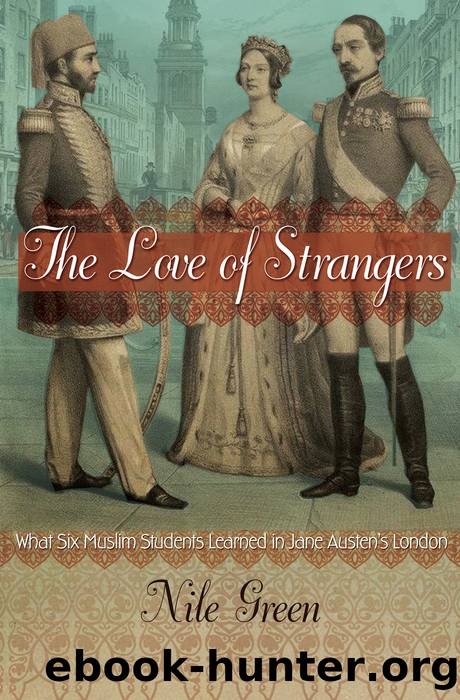The Love of Strangers by Green Nile

Author:Green, Nile
Language: eng
Format: epub
Publisher: Princeton University Press
Published: 2015-06-15T00:00:00+00:00
Fig. 21. Fresh from Wattsâs Workshop: Arabic Books of Psalms with Dr. Macbrideâs Corrections.
Source: Published with permission of the British and Foreign Bible Society, Cambridge.
During the very year in which Mirza Salih was learning to print, Wattsâs workshop took on a large contract for the Hindustani New Testament, for which he deployed an expanded set of his Persian font. The projectâs supervisor was none other than Professor Samuel Lee. Also being printed in Wattsâs workshop that year was an Arabic translation of the Book of Psalms, whose supervisor, with perfect symmetry, was Oxfordâs Dr. Macbride. Both projects were funded by the Bible Society. Around this time Watts was also printing an Arabic version of the New Testament for the Bible Society, the supervisor of which was again Professor Lee. Although when it was finally seen through the press, the Arabic Testament bore the date 1821, since such large projects took a long time to pass through Wattsâs hands there is every chance that the Arabic Testament was already in process when Mirza Salih was working in Mr. Wattsâs workshop. On a day-to-day basis, the learned young Muslimâs skills in both Arabic and Hindustani would certainly have been a huge help, since Wattsâs two professorial supervisors lived a whole dayâs journey away in the two university towns.
The two professors were not Mirza Salihâs only points of contact with Mr. Watts. For the latter was also closely associated with Sir Gore Ouseley, who as the Bible Societyâs vice president maintained regular contact with their printer. In Mr. Wattsâs Oriental Type-Foundry (to give his workshop its proper name) Mirza Salih was clearly surrounded with people he knew. Moreover, with its location on Temple Bar at the junction of the Strand and Fleet Street, the workshop was only five-minutesâ walk from the premises of Alexander Galloway on High Holborn, where Muhammad Ê¿Ali was pursuing the second part of his own apprenticeship. At the time, Temple Bar was filled with talk of inventions, with a mix of the latest gossip and revolutionary ideas. For with its centuries-old connections with the legal profession, it was now becoming the pulsing heart of English journalism that flourished on the adjoining Fleet Street. It was here that Englandâs coffeehouse culture had begun, where ideas and newspapers came free with a steaming cuppa. For someone with Mirza Salihâs interests in constitutional history, Temple Bar was a fascinating place to be. The winding alleyways that led off Temple Bar to the courtyard legal offices of the Inner and Outer Temple were filled with such history. Down one alley were the rooms where the great constitutional lawyer and founder of Englandâs liberties Sir Edward Coke had studied two centuries earlier; down another alleyway was the house where in the 1770s Dr. Samuel Johnson had produced his outspoken journal The Idler; another gulley led to the house where Englandâs finest journalist essayist, Charles Lamb, was raised. Fleet Street, and Temple Bar, was where the working man met the thinking man. As he made the shift from mirza to artistan, this suited Mirza Salih perfectly.
Download
This site does not store any files on its server. We only index and link to content provided by other sites. Please contact the content providers to delete copyright contents if any and email us, we'll remove relevant links or contents immediately.
| Bahrain | Egypt |
| Iran | Iraq |
| Israel & Palestine | Jordan |
| Kuwait | Lebanon |
| Oman | Qatar |
| Saudi Arabia | Syria |
| Turkey | United Arab Emirates |
| Yemen |
Empire of the Sikhs by Patwant Singh(22978)
The Wind in My Hair by Masih Alinejad(5034)
Rise and Kill First by Ronen Bergman(4705)
The Templars by Dan Jones(4629)
The Rape of Nanking by Iris Chang(4139)
12 Strong by Doug Stanton(3511)
Blood and Sand by Alex Von Tunzelmann(3140)
Babylon's Ark by Lawrence Anthony(2622)
The History of Jihad: From Muhammad to ISIS by Spencer Robert(2574)
No Room for Small Dreams by Shimon Peres(2320)
The Turkish Psychedelic Explosion by Daniel Spicer(2314)
Gideon's Spies: The Secret History of the Mossad by Gordon Thomas(2305)
Inside the Middle East by Avi Melamed(2305)
Arabs by Eugene Rogan(2263)
The First Muslim The Story of Muhammad by Lesley Hazleton(2219)
Come, Tell Me How You Live by Mallowan Agatha Christie(2212)
Bus on Jaffa Road by Mike Kelly(2104)
Kabul 1841-42: Battle Story by Edmund Yorke(1987)
1453 by Roger Crowley(1971)
